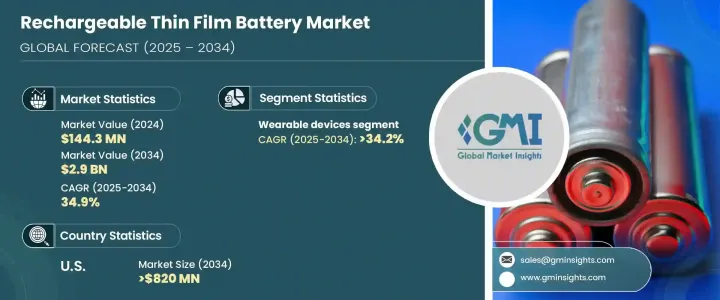
|
시장보고서
상품코드
1684773
세계의 충전식 박막 배터리 시장 : 기회, 성장 촉진요인, 산업 동향 분석, 예측(2025-2034년)Rechargeable Thin Film Battery Market Opportunity, Growth Drivers, Industry Trend Analysis, and Forecast 2025 - 2034 |
||||||
세계의 충전식 박막 배터리 시장은 2024년 1억 4,430만 달러로 평가되었고, 2025년부터 2034년까지 34.9%의 연평균 복합 성장률(CAGR)로 현저한 성장이 전망되고 있습니다.
이 성장의 주요 요인은 광범위한 산업에서 컴팩트하고 효율적이고 신뢰할 수 있는 에너지 저장 솔루션에 대한 수요가 증가하고 있다는 것입니다. 박막 배터리는 소형, 경량 설계, 장기간의 라이프 사이클에 걸쳐 안정된 성능을 발휘하는 능력 등, 독자적인 장점에 의해 지지를 모으고 있습니다. 이러한 특징은 특히 의료 기술, 웨어러블, 스마트 카드 등의 분야에서 휴대용 기기에 적용하기에 이상적입니다.

사물인터넷(IoT)의 급속한 확대는 공간 절약과 신뢰할 수 있는 에너지원의 필요성을 더욱 부각시켜 박막배터리 제조업체에 큰 비즈니스 기회를 가져오고 있습니다. 또한 에너지 밀도, 안전성, 지속가능성 향상 등 배터리 기술의 진보가 이러한 배터리의 매력을 높이고 있습니다. 친환경적이고 고성능 에너지 솔루션을 선호하는 산업이 증가함에 따라 박막 배터리는 선호되는 옵션으로 부상하고 있습니다. 시장은 R&D에 대한 투자를 확대하고 있으며, 이는 혁신을 가속화하고 이러한 첨단 에너지 저장 시스템의 채택을 촉진하고 있습니다.
| 시장 범위 | |
|---|---|
| 시작 연도 | 2024년 |
| 예측 연도 | 2025-2034년 |
| 시작 금액 | 1억 4,430만 달러 |
| 예측 금액 | 29억 달러 |
| CAGR | 34.9% |
웨어러블 기술 분야는 충전식 박막 배터리 시장의 성장의 주요 요인이 될 것으로 예상되고 2034년까지 수요는 CAGR 34.2%로 성장할 것으로 예측됩니다. 박막 배터리는 고에너지 밀도, 소형 폼 팩터, 고속 충전 기능으로 웨어러블 장비에 특히 적합합니다. 이러한 특성을 통해 제조업체는 스마트 워치, 피트니스 트래커, 건강 모니터링 가제트 등 소형화되어 미학적으로 매력적인 장치를 설계할 수 있어 효율이 향상되고 배터리 수명이 길어집니다. 웨어러블 기술에 대한 소비자 수요가 증가하고 있는 가운데, 박막 배터리는 혁신적이고 내구성 있는 제품의 개발에 필수적인 요소가 되고 있습니다. 웨어러블 산업의 엄격한 요구 사항을 충족하는 능력은 이 분야의 성장을 실현하는 중요한 요소가되었습니다.
미국의 충전식 박막 배터리 시장은 첨단 전자, 웨어러블, 의료기기에서의 소형 에너지 저장 솔루션 수요 증가에 견인되어 2034년까지 8억 2,000만 달러를 창출할 것으로 예측되고 있습니다. 배터리 설계, 특히 에너지 밀도와 안전성에 대한 혁신은 미국 제조업체들에게 이러한 분야의 진화하는 요구에 부응하는 최첨단 배터리를 생산할 수 있는 힘을 주고 있습니다. IoT 기기, 스마트 카드, 차세대 의료용 임플란트의 채용이 확대되고 있는 것도 시장 확대에 더욱 기여하고 있습니다. 게다가 지속가능하고 환경친화적인 기술에 대한 주목은 고체 박막 배터리로의 이동을 가속화하고 있습니다. 과학 연구자와 기술 기업의 협업은 이러한 에너지 저장 솔루션의 개발과 상업화를 추진하는데 있어서 매우 중요한 역할을 하고 있습니다. 이러한 노력을 통해 미국은 세계의 충전식 박막 배터리 시장의 리더로서의 지위를 확립하고 급속하게 진화하는 시장에서 경쟁력을 확보하고 있습니다.
목차
제1장 조사 방법과 조사 범위
- 시장의 정의
- 기본 추정과 계산
- 예측 계산
- 데이터 소스
- 1차 데이터
- 2차 데이터
- 유상
- 공적
제2장 주요 요약
제3장 업계 인사이트
- 생태계 분석
- 규제 상황
- 업계에 미치는 영향요인
- 성장 촉진요인
- 업계의 잠재적 위험 및 과제
- 성장 가능성 분석
- Porter's Five Forces 분석
- PESTEL 분석
제4장 경쟁 구도
- 전략 대시보드
- 혁신과 지속가능성의 전망
제5장 시장 규모와 예측 : 용도별, 2021-2034년
- 주요 동향
- 웨어러블 디바이스
- 의료기기
- 스마트 카드
- 소비자용 제품
- 기타
제6장 시장 규모와 예측 : 지역별, 2021-2034년
- 주요 동향
- 북미
- 미국
- 캐나다
- 멕시코
- 유럽
- 독일
- 영국
- 프랑스
- 이탈리아
- 스페인
- 오스트리아
- 스웨덴
- 아시아태평양
- 중국
- 일본
- 한국
- 인도
- 호주
- 세계 기타 지역
- 브라질
- UAE
- 사우디아라비아
제7장 기업 프로파일
- BrightVolt
- Cymbet
- Enfucell
- Ilika
- Imprint Energy
- Ion Storage Systems
- ITEN
- Jenax
- Johnson Energy Storage
- Molex
- Prieto Battery
- STMicroelectronics
The Global Rechargeable Thin Film Battery Market was valued at USD 144.3 million in 2024 and is expected to grow at a remarkable CAGR of 34.9% from 2025 to 2034. This growth is primarily driven by the increasing demand for compact, efficient, and reliable energy storage solutions across a wide range of industries. Thin film batteries are gaining traction due to their unique advantages, including their small size, lightweight design, and ability to deliver consistent performance over an extended lifecycle. These features make them ideal for applications in portable devices, particularly in sectors such as medical technology, wearables, and smart cards.

The rapid expansion of the Internet of Things (IoT) is further fueling the need for space-saving and dependable energy sources, creating significant opportunities for thin film battery manufacturers. Additionally, advancements in battery technology, such as improvements in energy density, safety, and sustainability, are enhancing the appeal of these batteries. As industries increasingly prioritize environmentally friendly and high-performance energy solutions, thin film batteries are emerging as a preferred choice. The market is also witnessing growing investments in research and development, which are accelerating innovation and driving the adoption of these advanced energy storage systems.
| Market Scope | |
|---|---|
| Start Year | 2024 |
| Forecast Year | 2025-2034 |
| Start Value | $144.3 Million |
| Forecast Value | $2.9 Billion |
| CAGR | 34.9% |
The wearable technology sector is expected to be a key driver of growth in the rechargeable thin film batteries market, with demand projected to grow at a CAGR of 34.2% through 2034. Thin film batteries are particularly well-suited for wearable devices due to their high energy density, compact form factor, and fast charging capabilities. These attributes enable manufacturers to design miniaturized and aesthetically appealing devices, such as smartwatches, fitness trackers, and health monitoring gadgets, that offer enhanced efficiency and longer battery life. As consumer demand for wearable technology continues to rise, thin film batteries are becoming an essential component in the development of innovative and durable products. Their ability to meet the stringent requirements of the wearables industry positions them as a critical enabler of growth in this segment.
The U.S. rechargeable thin film battery market is anticipated to generate USD 820 million by 2034, driven by the increasing demand for compact energy storage solutions in advanced electronics, wearables, and medical devices. Innovations in battery design, particularly in energy density and safety, are empowering U.S. manufacturers to produce cutting-edge batteries that cater to the evolving needs of these sectors. The growing adoption of IoT devices, smart cards, and next-generation medical implants is further contributing to market expansion. Additionally, the focus on sustainable and environmentally friendly technologies is accelerating the shift toward solid-state thin film batteries. Collaborations between scientific researchers and technology companies are playing a pivotal role in advancing the development and commercialization of these energy storage solutions. These efforts are positioning the U.S. as a leader in the global rechargeable thin film batteries market, ensuring its competitiveness in this rapidly evolving landscape.
Table of Contents
Chapter 1 Methodology & Scope
- 1.1 Market definitions
- 1.2 Base estimates & calculations
- 1.3 Forecast calculation
- 1.4 Data sources
- 1.4.1 Primary
- 1.4.2 Secondary
- 1.4.2.1 Paid
- 1.4.2.2 Public
Chapter 2 Executive Summary
- 2.1 Industry synopsis, 2021 – 2034
Chapter 3 Industry Insights
- 3.1 Industry ecosystem analysis
- 3.2 Regulatory landscape
- 3.3 Industry impact forces
- 3.3.1 Growth drivers
- 3.3.2 Industry pitfalls & challenges
- 3.4 Growth potential analysis
- 3.5 Porter's Analysis
- 3.5.1 Bargaining power of suppliers
- 3.5.2 Bargaining power of buyers
- 3.5.3 Threat of new entrants
- 3.5.4 Threat of substitutes
- 3.6 PESTEL Analysis
Chapter 4 Competitive landscape, 2024
- 4.1 Strategic dashboard
- 4.2 Innovation & sustainability landscape
Chapter 5 Market Size and Forecast, By Application, 2021 – 2034 (USD Million)
- 5.1 Key trends
- 5.2 Wearable devices
- 5.3 Medical
- 5.4 Smart cards
- 5.5 Consumer products
- 5.6 Others
Chapter 6 Market Size and Forecast, By Region, 2021 – 2034 (USD Million)
- 6.1 Key trends
- 6.2 North America
- 6.2.1 U.S.
- 6.2.2 Canada
- 6.2.3 Mexico
- 6.3 Europe
- 6.3.1 Germany
- 6.3.2 UK
- 6.3.3 France
- 6.3.4 Italy
- 6.3.5 Spain
- 6.3.6 Austria
- 6.3.7 Sweden
- 6.4 Asia Pacific
- 6.4.1 China
- 6.4.2 Japan
- 6.4.3 South Korea
- 6.4.4 India
- 6.4.5 Australia
- 6.5 Rest of World
- 6.5.1 Brazil
- 6.5.2 UAE
- 6.5.3 Saudi Arabia
Chapter 7 Company Profiles
- 7.1 BrightVolt
- 7.2 Cymbet
- 7.3 Enfucell
- 7.4 Ilika
- 7.5 Imprint Energy
- 7.6 Ion Storage Systems
- 7.7 ITEN
- 7.8 Jenax
- 7.9 Johnson Energy Storage
- 7.10 Molex
- 7.11 Prieto Battery
- 7.12 STMicroelectronics



















